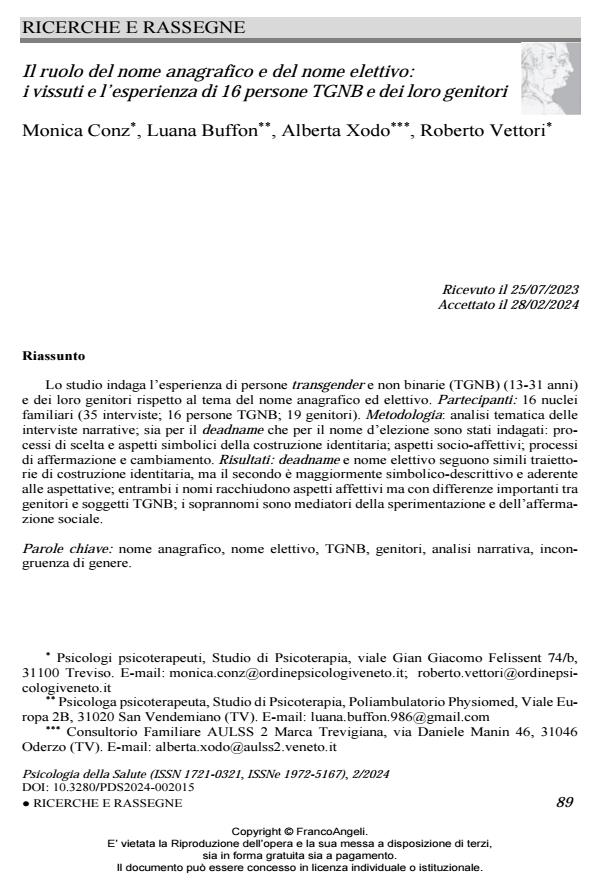Il ruolo del nome anagrafico e del nome elettivo: i vissuti e l’esperienza di 16 persone TGNB e dei loro genitori
Titolo Rivista PSICOLOGIA DELLA SALUTE
Autori/Curatori Monica Conz, Luana Buffon, Alberta Xodo, Roberto Vettori
Anno di pubblicazione 2024 Fascicolo 2024/2
Lingua Italiano Numero pagine 25 P. 89-113 Dimensione file 292 KB
DOI 10.3280/PDS2024-002015
Il DOI è il codice a barre della proprietà intellettuale: per saperne di più
clicca qui
Qui sotto puoi vedere in anteprima la prima pagina di questo articolo.
Se questo articolo ti interessa, lo puoi acquistare (e scaricare in formato pdf) seguendo le facili indicazioni per acquistare il download credit. Acquista Download Credits per scaricare questo Articolo in formato PDF

FrancoAngeli è membro della Publishers International Linking Association, Inc (PILA)associazione indipendente e non profit per facilitare (attraverso i servizi tecnologici implementati da CrossRef.org) l’accesso degli studiosi ai contenuti digitali nelle pubblicazioni professionali e scientifiche
Lo studio indaga l’esperienza di persone transgender e non binarie (TGNB) (13-31 anni) e dei loro genitori rispetto al tema del nome anagrafico ed elettivo. Partecipanti: 16 nuclei familiari (35 interviste; 16 persone TGNB; 19 genitori). Metodologia: analisi tematica delle in-terviste narrative; sia per il deadname che per il nome d’elezione sono stati indagati: processi di scelta e aspetti simbolici della costruzione identitaria; aspetti socio-affettivi; processi di af-fermazione e cambiamento. Risultati: deadname e nome elettivo seguono simili traiettorie di costruzione identitaria, ma il secondo è maggiormente simbolico-descrittivo e aderente alle aspettative; entrambi i nomi racchiudono aspetti affettivi ma con differenze importanti tra geni-tori e soggetti TGNB; i soprannomi sono mediatori della sperimentazione e dell’affermazione sociale.
Parole chiave:nome anagrafico, nome elettivo, TGNB, genitori, analisi narrativa, incongruen-za di genere.
Monica Conz, Luana Buffon, Alberta Xodo, Roberto Vettori, Il ruolo del nome anagrafico e del nome elettivo: i vissuti e l’esperienza di 16 persone TGNB e dei loro genitori in "PSICOLOGIA DELLA SALUTE" 2/2024, pp 89-113, DOI: 10.3280/PDS2024-002015